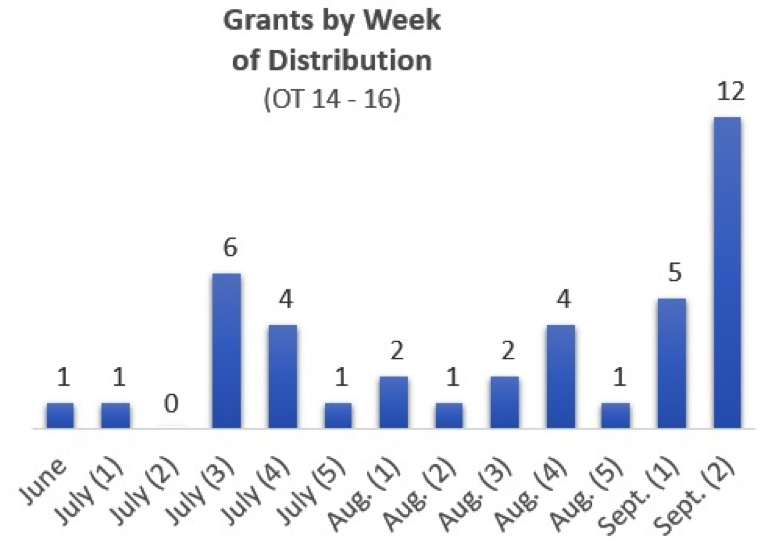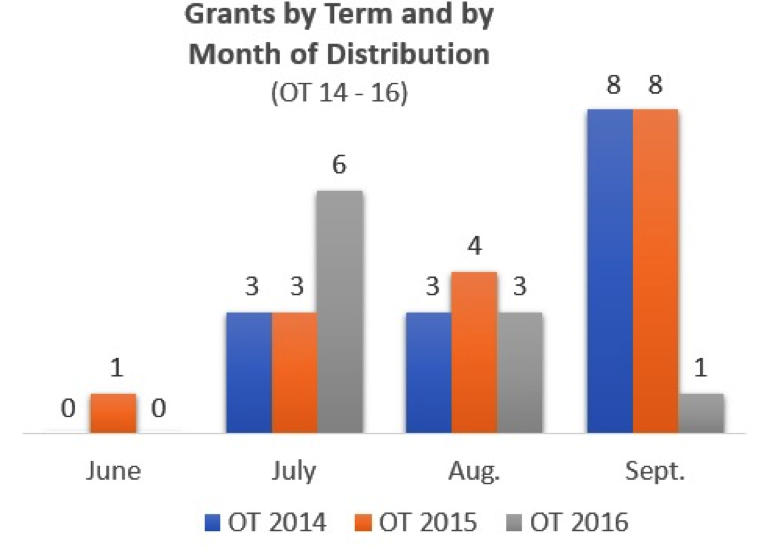Cert grants from the long conference: The September effect

on Sep 25, 2017 at 4:09 pm
The Supreme Court’s September 25 “long conference” is now behind us; if the past is any guide, the grants out of that conference should be released on Thursday, September 28. The initial grants out of the long conference are the single biggest exception to the ordinary rule that the Supreme Court will relist a case at least once before granting certiorari to give the justices and clerks the time necessary to do a second round of checks for vehicle problems. Presumably, they use the extra time they have over the summer to do that second look, so they don’t need to relist the cases before granting.
Thinking through the issue made me wonder about the timing of the distribution to chambers of cert materials (petition, brief in opposition, reply brief) for the cases the Supreme Court grants out of the long conference. I was curious about whether the initial grants released the same week as the conference were distributed earlier in the summer and the cases granted in October (or later), after relists, were distributed later in the summer. To find out, we analyzed all the long conference grants from the last three terms – every long conference since the court began routinely relisting cases before granting cert.
The actual numbers mildly bear out the predicted pattern; the relisted cases were almost entirely from August and September. But there were plenty of cases granted the week of the long conference that were first distributed as late as the second September distribution.
Overall, the numbers look like this:



A few things stick out:
- June distribution appears to be the kiss of death: Only one grant came from June distributions. Remember that the first week or two of June distributions are resolved at late June conferences before the Supreme Court leaves for the summer, so the full month of June cases isn’t under consideration at the long conference. But the number of grants is still unusually low. These distributions are made before new clerks arrive at the court beginning in July, so there’s no reason to believe that these cases would be affected by the arrival of new clerks who are thought to be wary of embarrassing themselves by recommending a grant in a case that is not truly cert-worthy or that has vehicle problems. Early July distributions likewise fare poorly: Only one grant came from the first two weeks of July distributions. Late June and early July thus represent a four-week Dead Zone that yielded only two grants over three terms.
- Later July distributions did reasonably well for summer distributions. Some court-watchers have speculated that outgoing clerks feel freer to recommend grants, particularly when they’re leaving the court and won’t have to live with it if they recommend a grant in a case that is later dismissed as improvidently granted.
- August is a light month. We are trying to determine whether fewer cases are distributed during this period; distributions are driven by the arrival of briefs in opposition, and it can be expected that lawyers might seek extensions for BIO deadlines to avoid having brief deadlines disrupt August vacations. Because most justices stagger the arrival of clerks during July, the low grant rate for August may also reflect the much-discussed “nervous clerk” effect.
- September is surprisingly heavy. September is a mirror image of June in that only a couple of weeks’ worth of distributions go to the long conference. But those two weeks yield a disproportionate share of long conference grants – 42.5 percent during OT 2014-OT 2016. But note the variability: After two terms of heavy grants from September distributions (eight and eight, respectively, for OT 2014 and OT 2015), there was only one in OT 2016. (There was a reduction in grants from the long conference that year, because the eight-member court was being very picky about grants; perhaps the September downturn was just a part of that general reluctance to grant.)
- There may be a self-fulfilling prophecy element to the timing. My colleague Jeremy Marwell suggested that, because it has long been understood that early summer is a dead zone, experienced Supreme Court counsel (and even some less experienced ones) may avoid filing cert-worthy petitions that would ordinarily be distributed in late June and early July, and instead seek extensions that push those cases to the latter half of the summer. Sure enough, the dockets for the granted cases in our sample reflect a number of extensions by petitioners’ counsel – mostly procured by specialist Supreme Court lawyers – that move case distributions from mid-June to mid-July, mid-July to mid-August, early August to early September, and – my favorite – mid-July to mid-September. It is impossible to tell, of course, whether those extensions were sought mainly to improve the timing or merely because specialist Supreme Court counsel are frequently brought in fairly late and need time to get up to speed. But it is a noteworthy coincidence in any event.
The long conference has a reputation for having a low grant rate. But on closer examination, not every week of the summer is equal; petitioners tend to do better in some than others. Late July and September distributions appear to be particularly promising, the second week in September especially so.
Thanks to Kent Piacenti for helping compile the data and drafting this post; thanks to Ralph Mayrell for composing the graphs.


